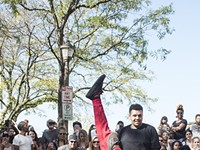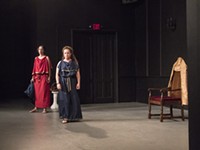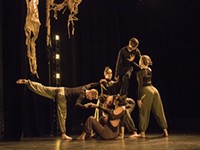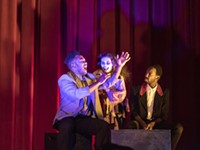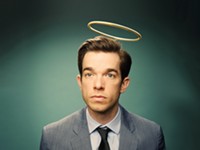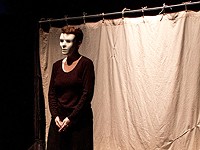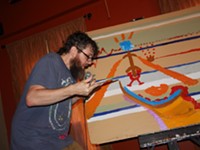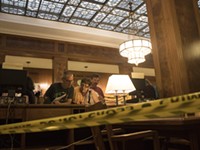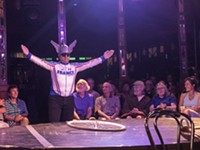The highly anticipated Sunday night premiere of "Labyrinth" at RMSC's Strasenburgh Planetarium did not disappoint. Co-created by BIODANCE's Missy Pfohl Smith and media artist W. Michelle Harris — who together presented the acclaimed "Anomaly" at the same venue in 2013 and 2016 — the multi-sensory show was performed to a full house as part of the KeyBank Rochester Fringe Festival. A heads-up, this article will have some show spoilers.
While nothing of the theme was given away in the Fringe catalog's description of the show, the subject matter is spelled out in the puzzle on the provided program. A series of bold-type letters dispersed through the text spell out two topical words: climate change.
The show tackles this concept in a somewhat abstract way, Pfohl Smith says. "It's a concern of mine — where we're headed in the environment. So 'Labyrinth' is a metaphor for me in that it feels like we're getting to a more sustainable place, but then we're rerouted, and it feels like we're right back where we started from."
The program lists the titles of the show's different parts: "Requiem for the Earth," "Ice Melt," "Wake-up Call," "Unwanted Turnings," "Under Water," "Rising," and "Labyrinth," each accompanied by smart selections of music by a diverse set of contemporary composers.
Members of BIODANCE, Eastman School musicians, the youth singing group Lyric Voices, and projected imagery all worked beautifully together through these seven enthralling movements. All senses were engaged with emotions connected to climate change: fear, anxiety, the feeling of helplessness, denial, urgency, resolve, and hope.
In the first movement, the group of youth singers, which includes Pfohl Smith's daughter, linger in the space behind the dome, calling out angelic notes. Projected stars wheel across the dome while below, dancers in flowing white garments gracefully mirror the celestial movements, illuminating one another with small lights bound to their arms. This motion dissolves into the darkness, giving way to a discord of percussive tick-tocks and chimes, with two dancers moving beneath images of a disappearing glacier in a mountain scene.
Projecting images on a huge hemisphere with an office-strength projector is quite different from projecting on a standard flat rectangle in high-powered HDMI, says W. Michelle Harris, who designed the show's visual elements.
"Fine details and subtle color variations won't work," Harris says. "You want any motion to seem anchored in place to avoid disorienting the audience or especially the dancers.
Her work involved finding filters and software to change rectangular flat imagery into something hemisphere-friendly, and discovering that "thick-marker graphics in super-saturated colors look wonderful in the planetarium," she says. "As a collaborator, I'm balancing the lighting and busyness of my imagery to complement what the dancers, musicians, and planetarium lighting people are doing."
Harris's task this year was to visually guide the audience "through aspects of the metaphorical labyrinth that is living with climate change," she says. "The physical world is still beautiful, but there have been changes. You'll definitely experience abstracted thick-marker imagery in 'Labyrinth,' but you'll see National Park Service and satellite imagery as well — and some of it will dance with the music."
Like klaxons, heavier percussion and saxophone notes usher in rapidly jolting gestures, dancers rush to and fro in the walkways behind the dome's screen, which is unexpectedly translucent under the right lighting.
Without warning, a laser projection floats low above the center of the space, with blue and green, oil-and-water shapes shifting like smoke on a flat plane of light above the dancers. This plane begins to twist and bend, adding a threatening, roiling tone to the space, and company members at times huddle together under umbrellas or blankets, their terrified and beleaguered expressions watching the sky.
"It is such a thrill to have such an amazing space as an artists' playground," Pfoh Smith says, adding that planetarium director Steve Fentress staff "have given us so much freedom to experiment and explore the space," which helped to lead the site-specific design.
And the planetarium's dome really begged for some kind of projected image, Pfohl Smith says. This is how the collaboration was sparked with Harris. Pfohl Smith and Harris met in the mid-aughts when they were contributors to the ImageMovementSound Festival, and they worked together in 2010 as members of Juanita Suarez's "Be Here Now" improvisational performance collective.
Then in 2013, Pfohl Smith and Emily Wozniak from SoundExChange approached Harris about making visuals for a show in the RMSC Planetarium dome, which resulted in the 2013 "Anomaly" performance.
In the second-to-last movement of "Labyrinth," a solo flautist stands piping under projected imagery of a leaf canopy, while dancers slowly begin passing and pulling a green cord, winding it around their bodies into a tangled web of connectivity.
The show concludes on a gentle, sacred-feeling note, with all members of the company — dancers, singers, and musicians — holding hands and moving in a line that doubles back on itself, as if walking the labyrinth. A projection above resembles foliage floating on flowing water, the company eventually ringing the space, held hands raised high. Time will tell if this indicates triumph or tribute to what has been lost.

